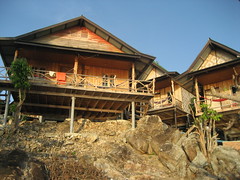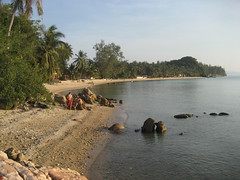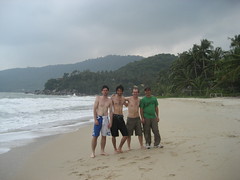A Rainforest Christmas and an Urban New Year
A whole lot has happened between the last update and now, so this is the longest post yet. Let's start with our journey from the island of Ko Phangan to the national park in Malaysia:
We knew it would take a long time to get from the beaches of Ko Phangan to the middle of Malaysia, but we had no idea it would take three full days of traveling. After a two taxi rides, a ferry trip, and two bus rides, our first night ended in a city called Hat Yai in southern Thailand. The rat-tacular city was shockingly infested with enormous rodents, and our dreary hotel was exactly how I pictured the apartment building in the first half of George Orwell's 1984, complete with a wretched group of zombie travellers with glazed eyes staring at a big TV screen in the lobby.

The following morning, we parted ways with Big Brother and the rats and boarded the pre-dawn train headed for the border. As the train pushed southward, our constantly changing group of fellow passengers began to slowly transition from the free-spirited, half-clothed Thais to the more conservative and covered Muslim Malay people. One of the reasons I wanted to go to Malaysia was to see a modern Muslim country that was culturally disconnected from the Muslim strongholds we all see so often on the news from the Arab Middle East. Except for the majority of women wearing head coverings, the style of dress seemed very similar to the west — jeans and t-shirts, jewelry, and makeup were common among most of the women we saw from the train window.

After we crossed hassle-free from Thailand into Malaysia, we planned to take a train from the border straight to the national park, but the train lines were all shut down thanks to heavy monsoon rains that flooded the tracks in several places along the route. So, we were stuck for the night in Kota Bharu, a city which is around 99% Muslim, making it one of the most Islamic areas of Asia. Except for one uncomfortable conversation with a fundamentalist taxi driver who blasted readings from the Koran over the car stereo and passionately ranted about US foreign policy, most of the people in Kota Bharu seemed fairly modern despite their deeply-held religious traditions.
Early the next morning, we climbed aboard the "jungle railway" — the nickname for the train from Kota Bharu to the national park. We knew that it wasn't an express train and that it would stop in every town, but in Malaysia they apparently use the word "town" very liberally — in my opinion, one dude carrying a suitcase standing outside a shack most definitely does not qualify as a town. Despite the painful slowness and absurdly frequent stops, the scenes from the train were beautiful, and the people-watching opportunities out the window were great too.



Finally, our seemingly endless three days of travel were over and we made it to Teman Negara National Park. Our first morning in the park, we went on a really informative nature walk which ended with a trip across a series of rickety bridges teetering high up in the rain forest canopy. Tom got completely freaked out, but Gerni and I were lovin' it. Here I am high up in the trees:

Our afternoon was filled with a trip to check out a nearby cave, located just outside a village populated by dark-skinned tribal villagers with large afros and no shirts, even for women. Except for a boom box (because if you're going to have afros, you must have a boom box) and some tarps to cover their huts, the village seemed like it had been completely untouched by modern life. I've been to some very small towns on this trip that I'd definitely classify as a village, but I've never seen anything quite like this. It was like taking a walk through an issue of National Geographic. After we shuffled like a weird white parade past the curious stares of the villagers, we headed into the darkness of the cave. A word to the wise: if you have a phobia of bats, do not go to the cave in Teman Negara National Park. As we navigated the cave with the help of a guide, we were completely surrounded by hundreds and hundreds of bats clinging to every wall. They brushed up against us as they flew through the cave, and the floor was completely covered in slimy guano (cue the Ace Ventura references). It was a really amazing experience, but not one for the squeamish. Back out into the bat-free air, we passed by the village again, then caught a ride back to our hotel on a small river-rocket boat, which was a blast:
On Christmas Eve, Gerni and I sadly parted ways with Tom who was going back up for another couple of days on the beach in Thailand before heading back home to California. The two of us spent the day on an absurdly difficult six mile hike toward a big hut in the middle of the rainforest where visitors can stay overnight. I know six miles doesn't sound very difficult, but the entire stretch of trail was like an obstacle course full of tricky river crossings, crazy-steep hills only climbable by rope, swinging on vines, quicksand-like mud, and spiked branches eager to stab careless hikers.


After coming across fresh sets of wild elephant and tiger tracks, we were very relieved to finally arrive in the hut before nightfall. We each took off our shoes only to find our socks covered in blood, thanks to the nasty leeches that had infiltrated our shoes during the hike. We desperately peeled off the sticky little bastards, wiped off the blood, and finally were able to relax enough to enjoy the gorgeous sights and sounds from outside the window of our hut, safely perched on stilt legs about 30 feet above the ground.
We woke on Christmas morning in the eerie blue mist of dawn with backaches from the plank beds in the hut, and started hiking back the way we came, which was slightly easier the second time around. We left the park on an afternoon boat to the nearby town of Jerantut, where we enjoyed a nice Christmas dinner of kung pao chicken before hopping on an overnight train south to Malaysia's capital city, Kuala Lumpur.
Since we came to Malaysia on a whim, I didn't really know much about the country or Kuala Lumpur. All I really knew is what I saw in the Sean Connery and Catherine Zeta Jones movie Entrapment which takes place in KL. (Although you might not have noticed the city at all, thanks to CZJ in that awesomely mind-erasing laser scene). I was surprised to see how ethnically diverse the city is compared to others in Asia. There is a solid mix of Indian, Malay, and Chinese people, along with a handful of other races blended in. Down the road from our funky hostel in the lively Chinatown area is a busy market with wall-to-wall knockoff vendors. Here's Gerni shopping for some pirated DVDs you can buy for a dollar each:
There's a great public transportation system here too. It's really easy to zip around town on the city's extensive and inexpensive light rail and monorail system. The system is so popular that the trains come every 2-3 minutes, and they're always packed to the brim:

We took the metro over to the KLCC shopping center, which sits under the awe inspiring Petronas Towers. When they were completed in 1998, the towers—the national symbol of progress and Kuala Lumpur's most notable tourist attraction—were the tallest buildings in the world. Although they've been overtaken in recent years by the crap-tastic Taipei 101 building, they are still huge. Huge isn't really the right word. ABSOLUTELY ENORMOUS is more like it. They're really easy on the eyes too. Here's a video so you can get a feel for the absurd size of these things:
After a few days checking out KL, we decided randomly to hop on a night bus to Singapore. Embarrassingly enough, I wasn't even sure what Singapore was before I went there. A city? A country? As it turns out, it's both. We had heard from other travelers that the country was boringly sterile, but I thought it was amazing there. I'll admit, Singapore does have some policies that sound a little bit like an overzealous middle school teacher is running the country. Gum-chewing is banned, you pay a hefty penalty for graffiti (they beat you!), there are very few areas to smoke cigarettes in public, and drug trade of any kind results in the death penalty. As a result, Singapore is immaculately clean, safe, and pleasant. It seems leaps and bounds more modern and progressive than anywhere else in Asia, or the rest of the world for that matter. Public transportation is cheap and top-notch, the people are smart and friendly, and the place oozes with charm. The city actively preserves historic buildings, and the streets are sprinkled with a diverse group of old Chinese shophouses, British colonial structures, modern skyscrapers, and more. Outside of the city center, much of the small country's natural landscape is preserved in the form of national parks. They have the highest standard of living in Asia and it shows.
A few weeks ago, I got done reading Tom Friedman's The Lexus and the Olive Tree which describes the process of globalization in terms of the balance and constant struggle between modern ways of living (represented by the Lexus car) and deeply-rooted traditions (represented by the olive tree). As a result, I've naturally been thinking about the places I visit in these terms. Singapore, more than anywhere I've ever been, seems to really have these two forces working together in perfect harmony. The city is quite diverse (for Asia at least), and it seemed like each culture's heritage and traditions were respected and encouraged, flourishing as a result. At the same time, they are investing tons of money into making their city a world-class cultural center and ultra-modern metropolis. To me, the country was living American ideals better than America does. I'm not trying to be overdramatic here, but Singapore stands as a model to the rest of the world. We were both seriously impressed.
I'm a big dork when it comes to museums, and I can tell you from personal experience that Asia's museums are generally pretty terrible compared to those in Europe or America. Singapore is noted for it's awesome museums, so Gerni and I went freakin' buckwild and visited six of them in 48 hours. Here's a rundown of the highlights from each, in the order that we visited them:
Singapore Art Museum (visit website)
Home to a lot of really great modern and contemporary art, and almost all of it was from Southeast Asian artists from both Singapore and the rest of the area, which was neat to see. The highlight was a large exhibit about Chen Wen Hsi, one of Singapore's most influential and prolific contemporary artists, whose style over his long career dabbled in an awesome array of styles from traditional scroll-n-stamp Chinese-style murals to large abstract textural pieces to formal portraits in traditional European style. The museum made me want to go back to our hostel and draw, which is just about all you can ask out of a museum. Here's Gerni checking out Chen Wen Hsi's work:

Singapore City Gallery (visit website)
The Urban Redevelopment Authority runs the great City Gallery, which documents and explains Singapore's urban past, present, and future development. Singapore is planning on expanding at a staggering rate, and they've already put a plan in place which would almost double (!) the size of their downtown. The museum was fascinating, and the exhibits really helped shed light on why the city outside the museum's walls was so amazing: because it was designed to be that way. Here I am checking out the large scale model of the city center:

Red Dot Design Museum (visit website)
Each year, the international Red Dot Design Awards are given to the best product designs, and this museum houses and describes many of the recent winners. The winners were both individuals and students as well as large design groups from companies like Canon and LG. The product designs themselves were diverse too, ranging from household appliances to chairs to air conditioning units to vacuums, and a whole lot more. Our favorite was a student-designed one-piece backpacking stove complete with built-in windscreen and fuel tank.
Singapore Philatelic Museum (visit website)
Normally, I wouldn't be terribly interested in a museum about stamps, but Singapore's museums had been great so far, so we decided to take the postal plunge and check it out. The museum was surprisingly great, and took an interesting look at both stamp history as well as history told through stamps. I especially enjoyed the oddities, rarities, and misprints section.
National Museum of Singapore (visit website)
Our fifth museum stop was to visit the brand spankin' new National Museum, which is housed in and old building from Singapore's British colonial days, but has recently been updated with a contemporary addition. I've never studied architecture, but I thought the contrast between old and new buildings was absolutely gorgeous:


We wandered around the National Museum's incredibly interesting exhibits about the history of Singapore broken up into themes: photography, fashion, food, and film. The exhibit design was the best I've ever seen in my life, and it really brought the country's history alive, punctuated by a handful of stunningly-produced short documentaries scattered throughout the exhibits' numerous flatscreens.
We happened to visit the National Museum during its month-long grand opening festivities, and one of the month's many events took place while we were there: a performance by Project Bandaloop, a high-flying contemporary dance group from Oakland, California. So, I don't know if you've ever seen anyone do contemporary interpretive dance before, but... uhh... well, there's something sort of... awkwardly hilarious about it. It's really hard for me to keep a straight face while watching a guy wearing tights dance around a stage attempting to express the concept of suffering. It's just kind of weird. Like watching someone successfully try to cry on cue. Anyway, they eventually moved on to what the group is known for: mid-air acrobatic dance wearing harnesses, which I started to really enjoy the more the night went on. Here's a video so you can get a feel for it:
Mint: Museum of Toys (visit website)
Our last of six museum visits, but definitely one of the best. Spread over a few floors were thousands of well-displayed and explained toys from all over the world, dating mostly from the 1940s through the late '80s. There were lots of early one-of-a-kind Mickey Mouse toys, memorabilia from Beatlemania, chinese ceramic dolls, and much more. For me, the highlight was definitely the Star Wars action figures, all in great condition in their original packaging, which I had never seen before in person. Although it doesn't help me win the hearts of beautiful ladies, I have a decent-sized collection of Star Wars memorabilia myself, and it was really cool to see some really top-notch pieces in the museum's collection. Another favorite from the museum was the 60s-era John F. Kennedy action figure complete with newspaper, rocking chair, and leg-crossing action. And as we all know, there's nothing that keeps the kids more entertained than watching JFK sit and read the paper. Look, he's even reading an article about himself:

We left Singapore on another overnight bus and arrived back here yesterday in Kuala Lumpur for New Years Eve. We went out for the celebration at the Petronas Towers where we caught a quick fireworks show and then went out to celebrate 2007 at the main bar street. Beer was too expensive and the bumpin' techno music was too terrible, so we drank until the early morning outside a gas station instead, which was much more our speed. Plus, we met a ton of great locals during our loitering spree. We're flying out of here on the 4th headed for Phnom Penh in Cambodia, so our next update will likely be from there.
Congrats, you made it to the bottom! I'm glad, because I've been working on this post for the majority of the year. Thanks for reading, and happy 2007!
Ryan
UPDATE! Every once in a great while, I check to see what keywords people are using to get to this site. Someone recently showed up thanks to Googling "how to make camel poop bread," which I'll definitely chalk up as one of the proudest moments of my life.


















